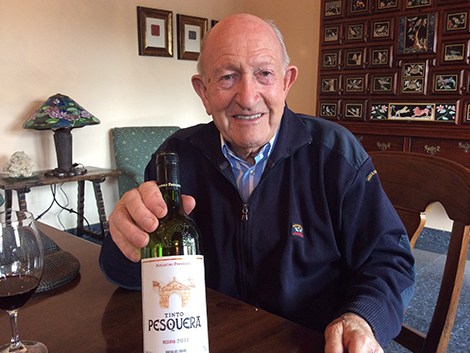

 Alejandro Fernández in 2015. Photo credits: A.C.
Alejandro Fernández in 2015. Photo credits: A.C.
The legendary Castilian producer, who converted the type of reds he loved to drink into the style that went on to define Ribera del Duero, died at the age of 88 in Santander.
Alejandro Fernández passed away last Saturday. He was in Santander with Eva, his youngest daughter and the winemaker in charge of Grupo Pesquera for many years, reported the Spanish newspaper El Norte de Castilla yesterday. "His way of loving Ribera del Duero leaves an indelible mark", the DO Ribera del Duero said in a message on Twitter.
In recent years, his name was frequently in the media because of the disputes he had with his estranged wife Esperanza and their other three daughters, Lucía, Olga and Mari Cruz, over who controlled the group of wineries he had created. The conflict highlights the challenges family businesses face when it comes to continuing the legacy and handing over the company to the heirs.
Bolstered by the success of Pesquera, Fernández created a second bodega in Ribera del Duero called Condado de Haza to make single vineyard wines. He also founded Dehesa La Granja in Zamora, sold under the VT Castilla designation, as well as El Vínculo in Campo de Criptana (Ciudad Real). He also ventured into the hotel business with his AF Pesquera hotel, located in Peñafiel (Valladolid).
One of his last (and rather emotional) public appearances took place during a tribute to the pioneers in Ribera del Duero at the Duero International Wine Fest in September 2018. This piece, published in Spanish Wine Lover in 2015 to mark the 40th anniversary of Pesquera's first vintage, captures the essence of his guiding principles and includes opinions from people in the industry who worked closely with him.
Fernández was an entrepreneur who started out designing and manufacturing agricultural equipment to produce sugar beet. With the money he earned from several patents, he was able to finance his wine business.
What set him apart was his absolute confidence in the quality of the Tempranillo grape variety, particularly in Ribera, and in the ageing properties of the wines. It may seem obvious today, but in the mid-1970s the gold standard for red wine in Spain were fine, pale-coloured riojas with long ageing times in barrels. His vision was completely the opposite: dark-coloured wines with Ribera's natural concentration and abundant fruit. Perhaps that's why the wine was a roaring success in the US (Parker gave his blessing to the 1982 vintage, the same year the DO Ribera del Duero was created) before it triumphed in Spain.
The message was both clear and powerful: a grape variety, a style and a man who knew his homeland. He was proud of it -he named the wine after his village, Pesquera del Duero- and had the energy and drive to travel the world with a bottle of red under his arm to promote it. Pesquera and Alejandro Fernández told the story of the new Spanish reds and the rise of a region with a continental and harsh climate capable of challenging Rioja. The story, on the other hand, fitted perfectly with the beginning of Robert Parker's reign and a bolder style of reds.
He was an inimitable character. Direct, unabashed, generous, and always willing to uncork a bottle to make his wines known to a greater number of people. He successfully used his easy-going, countryman manners like no one else. He never held formal tastings, preferring instead to let the wines speak for themselves. It was enough for him to point out how good they were or to come up with comments like "wine is very good for making love" or "Tempranillo is the best variety in the world" (all his bodegas, in fact, use this grape). In this video with Jancis Robinson MW, whom he incidentally calls "maja" (sweetheart, min. 16), a term he usually did when addressing women, he unashamedly points out that Pesquera is one of the four best wines in the world, along with Pétrus, Lafite and "Román" Conti.
Of course, this would have been insufficient without good wines to back it all up. And Alejandro had very personal and even innovative ideas about the grapes he needed and how to process them. He was not particularly fond of traditional goblet-trained vineyards. In his quest for freshness, he was one of the first to plant vines on the Ribera del Duero high plateau and he usually trained them on trellises. He always insisted on picking the grapes at the right time, with smooth skins and avoiding overripeness. He had no qualms about fermenting some of his first vintages with stems until he had a cellar to work under proper conditions. He always liked to age and preserve his wines in caves or underground cellars, at a constant temperature. He refused to filter because he felt that his wines could lose substance and personality. Instead, he strongly recommended decanting. He liked to serve red wines cold, at cellar temperature, and to see them developing in the glass.
Pesquera's tremendous growth beyond one million bottles, the company's expansion and the boom of Ribera del Duero itself in the 1990s and early 2000s gradually diluted the message. Times have undoubtedly changed: the Parker years are over and today there is a greater emphasis on finesse; powerful Ribera del Duero reds are not as fashionable as they once were. The challenge ahead for the Fernández family is to reinvent the brand in a very different context.
These days it is not easy to find bottles from the eighties and nineties of his legendary Janus and Millenium reds (a quick online search yielded no results), special vintages designed for ageing that made an impression on a whole generation of wine lovers and professionals. With the disappearance of Alejandro Fernández, a whole era of Spanish wine comes to an end.